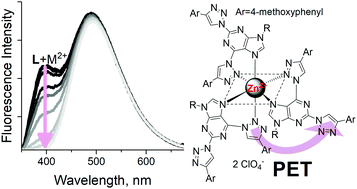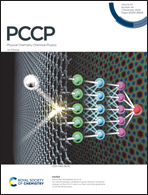Proof of principle of a purine D–A–D′ ligand based ratiometric chemical sensor harnessing complexation induced intermolecular PET†
Abstract
A comprehensive photophysical study of a series of purines, doubly decorated at C2 and C6 positions with identical fragments ranging from electron acceptor to donor groups of different strengths, is presented. The asymmetry of substitutions creates a unique molecular D–A–D′ structure possessing two independent electronic charge transfer (CT) systems attributed to each fragment and exhibiting dual-band fluorescence. Moreover, the inherent property of coordination of metal ions by purines was enriched due to a presence of nearby triazoles used as spacers for donor or acceptor fragments. New molecules present a bidentate coordination mode, which makes the assembly of several ligands with one metal cation possible. This property was exploited to create a new concept of a ratiometric chemical fluorescence sensor involving the photoinduced electron transfer between branches of different ligands as a mechanism of fluorescence modulation.



 Please wait while we load your content...
Please wait while we load your content...